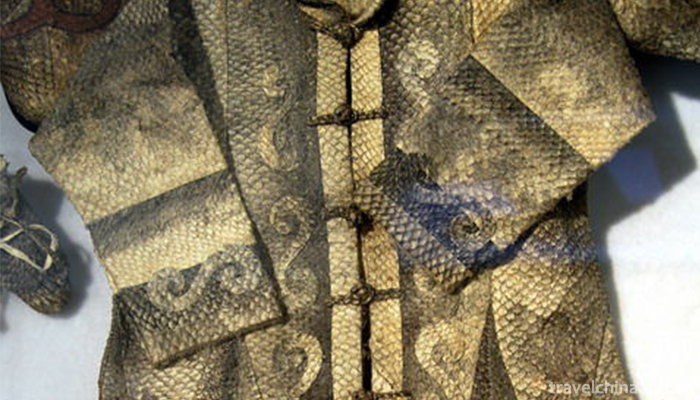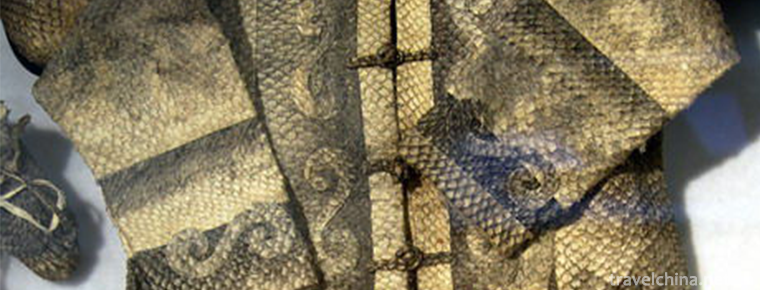Fish Skin Making Techniques of Hezhe Nationality
Fish Skin Making Techniques of Hezhe Nationality
Fish skin making techniques of Hezhe nationality, traditional handicraft techniques of Raohe and Fuyuan in Heilongjiang Province, are one of the national intangible cultural heritages.
Traditional fish skin technology includes a set of complex processing processes, including peeling, drying, ripening and softening, splicing and stitching, artistic decoration and other steps.
On May 20, 2006, the technique of making fish skin of Hezhe nationality was approved by the State Council and listed in the first batch of national intangible cultural heritage list, numbered_-85.
historical origin
The Hezhe people are mainly distributed in Raohe and Fuyuan counties of Heilongjiang Province. The Hezhe people living along the river are still mainly fishing. They are good fishermen, young and old. They catch fish, eat fish, build houses with fish skin, build boats and make clothes. Fish skin products are made from northern cold-water fish skin. The cold-water fish skin has certain thickness and toughness. It is relatively wear-resistant and easy to use in production and life.
The Hezhe people only have language but no words, so the exact time of the beginning of the fishskin making skills of the Hezhe people is no longer available. However, in their oral "Imakan" and folk stories about national history, there are many articles related to fish skin culture and production techniques, such as fish skin clothes, fish skin bags, tools for cooked fish skin "empty storehouse" and "Hairigen", which show that the fish skin culture of Hezhe nationality has a long history. In ancient Chinese books, there are records of the ancestors of Hezhe people, the Tang Dynasty Jingju, and the Jin Dynasty Qiliemi's custom of using fish skin. After the formation of the Hezhe ethnic group in the late Ming and early Qing Dynasties, records of their unique fish skin culture appeared more frequently in Chinese and foreign literature.
Fish skin culture has a long history. Although many nationalities had fish skin culture in history, only Hezhe people in Jiejinkou Township of Tongjiang City in Heilongjiang Province inherited it from the Qing Dynasty. Before the 1950s, most Hezhe people preferred to wear clothes made of fish skin, mainly trousers, gloves, leggings and women's long clothes.
Inheritance and protection
Inheritance value
Fish skin making is a unique fishing and hunting culture of the Hezhe nationality, a microcosm of the historical development of the Hezhe nationality, and an important part of China's excellent traditional culture.
Fishskin costumes of Hezhe nationality include fishskin gowns, trousers and boots. In addition, some young people use traditional fish skin clipping technology to create modern fish skin crafts and fish skin paintings, so that fish skin culture extends to tourism, art and other fields. The skill of making fish skin of Hezhe nationality is the historical witness that Hezhe people actively adapt to and transform their living environment.
Inheritance status
With the development and progress of history, silk and cloth clothing gradually replaced fish skin clothing. Following the principle of using fish skins in advance and abandoning in retreat, the traditional handicraft of fish skins, which lost its use value, has gradually changed, and many primitive traditional skills have been forgotten by people. Cotton thread replaces fish skin thread. People don't even know how to make fish skin thread. The application of dyed pigments has developed from the natural application of natural plants and flowers to the application of chemical pigments. In the 1940s, few people wore fish skin clothes. In the 1960s, fish skin clothing as a practical product has been withdrawn from the historical stage. Few people can make fish skin clothes according to the traditional process system.
Inheriting characters
Ju Wenfeng, female, born on February 2, 1952, was elected as the first representative successor of national intangible cultural heritage projects in 2006. Heilongjiang Province declaration, project: Hezhe fishskin production skills.
protective measures
In order to preserve and inherit this skill, the people of Hezhe nationality have changed their fishskin products from practical to aesthetic, developed fishskin national costumes, fishskin crafts, and fishskin paper-cut art, so that the fishskin production technology has found a new soil for survival and development in contemporary society.
Since the 1990s, some researchers have gone deep into Hezhe Township of Jinkou Street in Tongjiang City, Bacha Hezhe Township in Fuyuan County, Hezhe Township of Four Rows in Raohe County and Aoqihezhe Village in Jiamusi City, and rescued the important inheritors of fish skin making skills and the skills they mastered, and achieved certain results. From 2004 to 2005, Heilongjiang Provincial Culture Department strengthened the rescue, excavation and protection of fishskin production technology, and established the "Hezhe fishskin production technology" research group. In 2006, Hezhe fish skin making technology was declared and listed in the first batch of national intangible cultural heritage protection list. Juventus Phoenix was selected as the national intangible cultural heritage project Hezhe fish skin making technology successor. In 2009, in order to inherit this national culture, Juventus Phoenix and Youzhongmei went to Beijing to show their fishskin making skills. Fishskin purse and other handicraft products were welcomed.
social influence
Important exhibition
In 2003, the salmon skin costumes of the Hezhe nationality were displayed in the Chinese Cultural Year of France. In the "China Ethnic Minority Garments Exhibition" of the Hong Kong Cultural Museum, the traditional fish skin costumes of the Hezhe nationality were well received by Chinese and foreign guests and entered the international horizon.
On April 4, 2014, the first Heilongjiang Hezhe Fish Skin Art Exhibition opened in the Heilongjiang Provincial Library. Nearly 400 pieces of fish skin artworks with different shapes and exquisite production are exhibited here for half a month. This is the first special exhibition of the Fish Skin Art Project of Hezhe Nationality, a national intangible cultural heritage, in Heilongjiang Province.
Cultural anecdotes
Fish skin is also needed in the funerals of the Hezhe people. Fish skin wedding gowns are actually only worn for three days during the marriage process, and then they will be put away and preserved properly. When you die, put on another world and start living in another world from the time you get married. The cuffs on a hunting suit are usually wrapped around the cuffs and taken to another world to continue hunting in another world.


-
1.steamed vermicelli roll
Intestinal powder originated in Luoding, Guangdong Province, has been spread throughout the country. According to geography (taste), it can be distinguished from the well-known
Time 2018-11-02 -
2.Terracotta Army
Terracotta Warriors and Horses, terracotta warriors and horses of Qin Shihuang, also referred to as terracotta warriors and horses or terracotta warriors and horses of Qin Dynasty
Time 2018-11-11 -
3.Shanghai Ocean Aquarium
Shanghai marine aquarium is located at 1388 Lujiazui Ring Road, Pudong New Area, Shanghai, China, next to the Oriental Pearl Tower. Singaporean Xingya Group and Chinese Poly Group have jointly
Time 2018-12-19 -
4.Zhangye Great Buddhist Temple
The Great Buddha Temple was built in the first year of Yongan, Xia Dynasty (1098), formerly known as the Kaye Tathagata Temple, in the ninth year of Yongle, Ming Dynasty (1411), and in the seventeenth
Time 2019-03-16 -
5.Eight Immortals Crossing the Sea Make Arhats
Eight Immortals Crossing the Sea and Arhat is a famous dish, which belongs to Confucian cuisine. Various raw materials, rich and fresh soup, beautiful color, such as eight immortals and Luohan
Time 2019-03-27 -
6.White Tea Making Skills Fuding White Tea Making Skills
The production technology of Fuding White Tea is the central process of creating Fuding White Tea. It has superb production method and unique scientific and artistic charm
Time 2019-04-03 -
7.Dan GA harmonics
Jia Hao, which means "grand singing and dancing performance" in Chinese, is a kind of collective dance, usually performed in the Tibetan New Year and major festivals every year. Men
Time 2019-04-25 -
8.Custom of sacrificing ancestors to the great locust tree in Hongdong
During the period from Hongwu to Yongle in the Ming Dynasty, an unprecedented migration took place under the great locust tree in Hongtong. It lasted 50 years and moved 18 times
Time 2019-05-03 -
9.Music dance
Musical dance is popular on the South Bank of the Red River, so it is also known as "Jiangwai" Yi dance. The Yi language is called "Zai Bi", which means jumping up in pairs.
Time 2019-05-11 -
10.The seafood tune of the Yi nationality
The seafood tune of the Yi nationality Shiping Yi seafood tune, also known as "Shiping tune" and "Quzi", is commonly known as "inverted paddle". It is named after a herba
Time 2019-07-12 -
11.Add another festival beside the word ants of the Zhuang nationality
The Zhuangs Ant Festival (insect word plus another) is mainly prevalent in the Hongshui River Basin in the northwest of Guangxi Zhuang Autonomous Region. It is named "Ant (insect word plus anothe
Time 2019-08-16 -
12.Deyang hydrology
The rivers in Deyang City belong to Tuojiang River and Fujiang River system. The main rivers are Mianyuan River, shiting River, Yazi River, Qingbai River, Kaijiang River, etc. The Northwest Mountainous Area of the city is located in the north of Shifang and Mianzhu
Time 2020-12-14